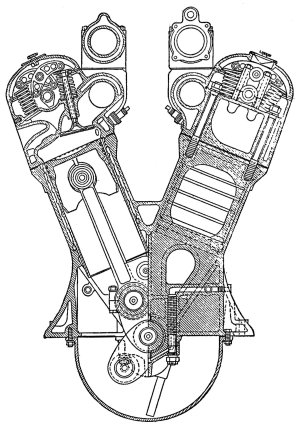
In the article section entitled, "The Mystery of Patent No GB281,486 (1926)", the question of where the reference to monoblock cylinder construction featuring open, wet liners with upper locating flanges comes from is posed. This design was not used by Rolls-Royce until the PV-12 engine was first proposed in 1932.
In 2012, a monograph titled Duesenberg Aircraft Engines by Bill Pearce (Old Machine Press) was published. This book deals with not only engines that were designed by the Duesenberg team but also engines that were manufactured by the company to other people's specifications. One of these non-Duesenberg engines was the U-16 Bugatti, which was modified considerably under the direction of Charles Brady King, an engineer of wide experience, the resultant motor then being referred to as the King-Bugatti.
Prior to his work on the Bugatti engine, Charles King had designed an engine aimed at replacing the Liberty. To this end, the King 550 HP was a V-12 with the cylinder banks set at 45°, i.e., the same as the Liberty. That was about the only similarity because the rest of the design was incredibly advanced for its time, in fact the resemblance of the R-R PV-12 (1932) to the King 550 HP (1918) is very close.
Thus, this engine becomes a very good candidate as to what was being referred to in the 1926 R-R patent. A full report on the engine was published in the April 1, 1919 edition of the Aviation and Aeronautical Engineering journal, this information being repeated in the Wardrop & Sherbondy Textbook of Aero Engines published in 1920. A firm such as Rolls-Royce would subscribe to many technical journals and magazines and thus, it is quite likely that the A & A E was one of them.
The King 550 HP engine was of large capacity as compared to the Kirkham and Curtiss wet-liner engines of the era which were in the under-20 litre category. The King was 1,995 in³ (32.9 litres) which is about the same size as the WWII Daimler-Benz DB 601. It was more than 20% larger in capacity than the Liberty. In photos of the King engine, the quality of the castings looks to be of a very good standard, which is remarkable given the recorded troubles manufacturers had with the Hispano-Suiza V-8 parts. Both Curtiss and Rolls-Royce experienced much difficulty with the large casting of the upper crank case/cylinder blocks unit and in both cases had to resort to separating it into three parts.
The King engine was designed with articulated connecting rods which were popular in the US for V-type aero-engines but usually gave trouble when higher outputs were required. In retrospect it appears that the US military missed a golden opportunity to develop an excellent aero-engine when the decision not to proceed with the King 550 HP was made.
The King 550 HP transverse section (left) shows many advanced features, including:
1) separate cylinder head
2) cylinder liner open at upper end
3) coolant in direct contact with outside of cylinder liner
4) upper flange on liner for good location of the barrel and sealing of combustion chamber.
(Aviation & Aeronautical Engineering)